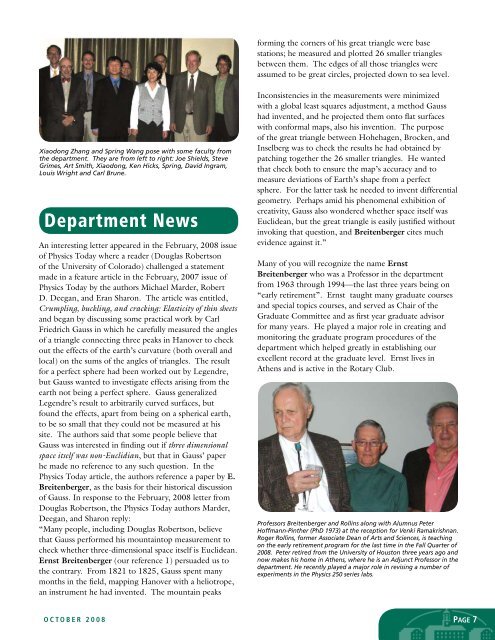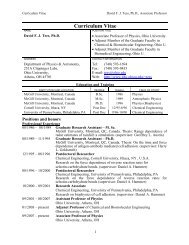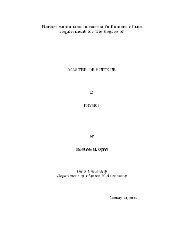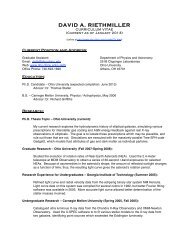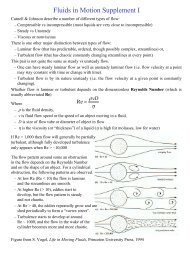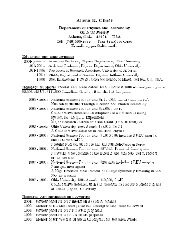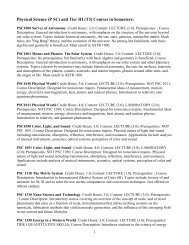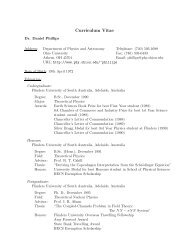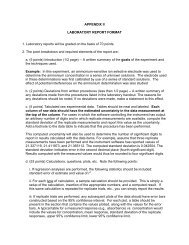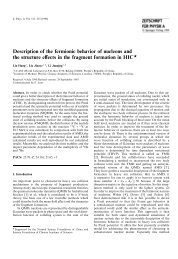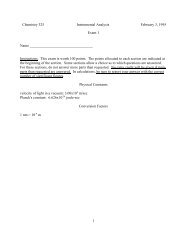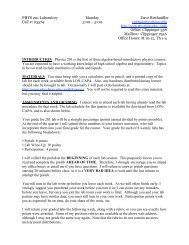Physics & Astronomy Alumni Newsletter PDF - Department of ...
Physics & Astronomy Alumni Newsletter PDF - Department of ...
Physics & Astronomy Alumni Newsletter PDF - Department of ...
Create successful ePaper yourself
Turn your PDF publications into a flip-book with our unique Google optimized e-Paper software.
forming the corners <strong>of</strong> his great triangle were base<br />
stations; he measured and plotted 26 smaller triangles<br />
between them. The edges <strong>of</strong> all those triangles were<br />
assumed to be great circles, projected down to sea level.<br />
Xiaodong Zhang and Spring Wang pose with some faculty from<br />
the department. They are from left to right: Joe Shields, Steve<br />
Grimes, Art Smith, Xiaodong, Ken Hicks, Spring, David Ingram,<br />
Louis Wright and Carl Brune.<br />
<strong>Department</strong> News<br />
An interesting letter appeared in the February, 2008 issue<br />
<strong>of</strong> <strong>Physics</strong> Today where a reader (Douglas Robertson<br />
<strong>of</strong> the University <strong>of</strong> Colorado) challenged a statement<br />
made in a feature article in the February, 2007 issue <strong>of</strong><br />
<strong>Physics</strong> Today by the authors Michael Marder, Robert<br />
D. Deegan, and Eran Sharon. The article was entitled,<br />
Crumpling, buckling, and cracking: Elasticity <strong>of</strong> thin sheets<br />
and began by discussing some practical work by Carl<br />
Friedrich Gauss in which he carefully measured the angles<br />
<strong>of</strong> a triangle connecting three peaks in Hanover to check<br />
out the effects <strong>of</strong> the earth’s curvature (both overall and<br />
local) on the sums <strong>of</strong> the angles <strong>of</strong> triangles. The result<br />
for a perfect sphere had been worked out by Legendre,<br />
but Gauss wanted to investigate effects arising from the<br />
earth not being a perfect sphere. Gauss generalized<br />
Legendre’s result to arbitrarily curved surfaces, but<br />
found the effects, apart from being on a spherical earth,<br />
to be so small that they could not be measured at his<br />
site. The authors said that some people believe that<br />
Gauss was interested in finding out if three dimensional<br />
space itself was non-Euclidian, but that in Gauss’ paper<br />
he made no reference to any such question. In the<br />
<strong>Physics</strong> Today article, the authors reference a paper by E.<br />
Breitenberger, as the basis for their historical discussion<br />
<strong>of</strong> Gauss. In response to the February, 2008 letter from<br />
Douglas Robertson, the <strong>Physics</strong> Today authors Marder,<br />
Deegan, and Sharon reply:<br />
“Many people, including Douglas Robertson, believe<br />
that Gauss performed his mountaintop measurement to<br />
check whether three-dimensional space itself is Euclidean.<br />
Ernst Breitenberger (our reference 1) persuaded us to<br />
the contrary. From 1821 to 1825, Gauss spent many<br />
months in the field, mapping Hanover with a heliotrope,<br />
an instrument he had invented. The mountain peaks<br />
Inconsistencies in the measurements were minimized<br />
with a global least squares adjustment, a method Gauss<br />
had invented, and he projected them onto flat surfaces<br />
with conformal maps, also his invention. The purpose<br />
<strong>of</strong> the great triangle between Hohehagen, Brocken, and<br />
Inselberg was to check the results he had obtained by<br />
patching together the 26 smaller triangles. He wanted<br />
that check both to ensure the map’s accuracy and to<br />
measure deviations <strong>of</strong> Earth’s shape from a perfect<br />
sphere. For the latter task he needed to invent differential<br />
geometry. Perhaps amid his phenomenal exhibition <strong>of</strong><br />
creativity, Gauss also wondered whether space itself was<br />
Euclidean, but the great triangle is easily justified without<br />
invoking that question, and Breitenberger cites much<br />
evidence against it.”<br />
Many <strong>of</strong> you will recognize the name Ernst<br />
Breitenberger who was a Pr<strong>of</strong>essor in the department<br />
from 1963 through 1994—the last three years being on<br />
“early retirement”. Ernst taught many graduate courses<br />
and special topics courses, and served as Chair <strong>of</strong> the<br />
Graduate Committee and as first year graduate advisor<br />
for many years. He played a major role in creating and<br />
monitoring the graduate program procedures <strong>of</strong> the<br />
department which helped greatly in establishing our<br />
excellent record at the graduate level. Ernst lives in<br />
Athens and is active in the Rotary Club.<br />
Pr<strong>of</strong>essors Breitenberger and Rollins along with Alumnus Peter<br />
H<strong>of</strong>fmann-Pinther (PhD 1973) at the reception for Venki Ramakrishnan.<br />
Roger Rollins, former Associate Dean <strong>of</strong> Arts and Sciences, is teaching<br />
on the early retirement program for the last time in the Fall Quarter <strong>of</strong><br />
2008. Peter retired from the University <strong>of</strong> Houston three years ago and<br />
now makes his home in Athens, where he is an Adjunct Pr<strong>of</strong>essor in the<br />
department. He recently played a major role in revising a number <strong>of</strong><br />
experiments in the <strong>Physics</strong> 250 series labs.<br />
OCTOBER 2008 Page 7


